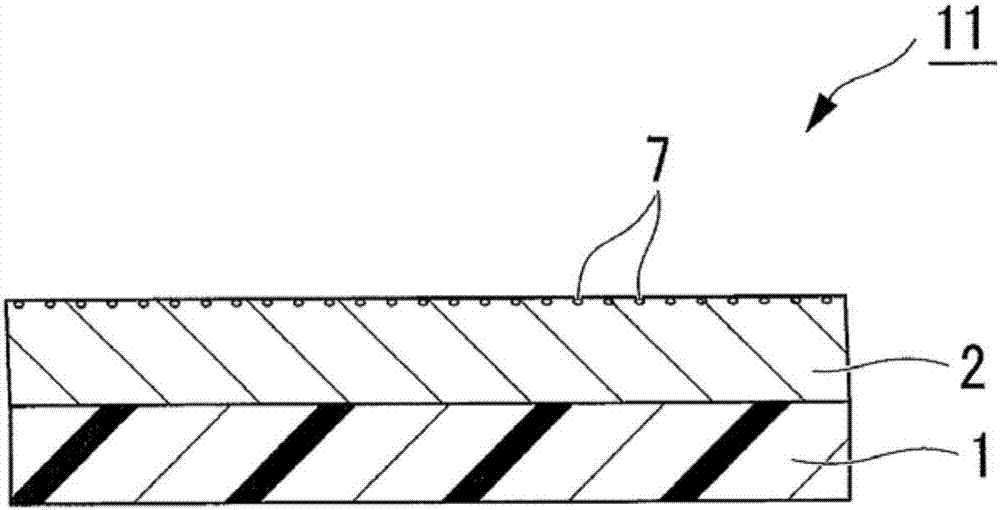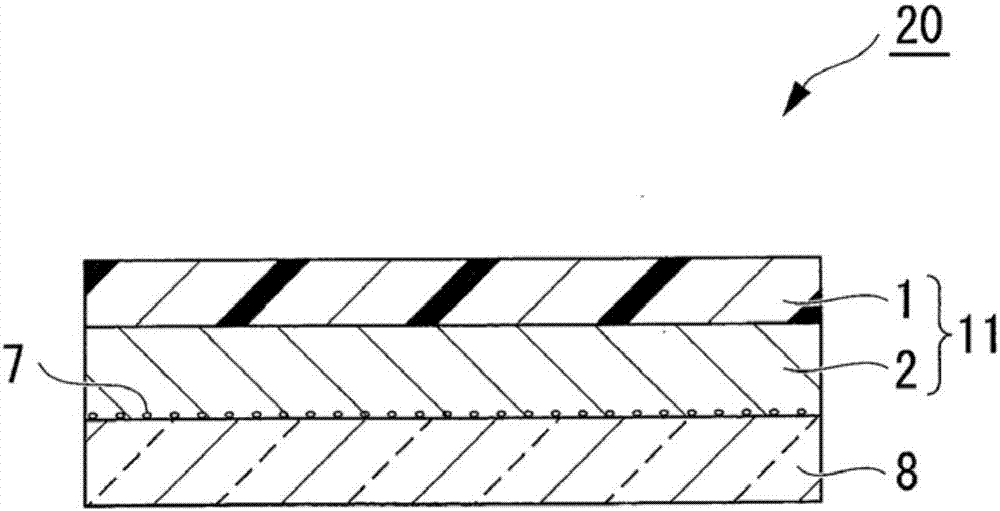Method for producing antistatic surface-protective film and antistatic surface-protective film
A surface protection film, antistatic technology, applied in film/sheet adhesives, instruments, optics, etc., can solve the problems of circuit components such as driver IC damage, liquid crystal molecular orientation damage, etc., to achieve the effect of excellent pollution
- Summary
- Abstract
- Description
- Claims
- Application Information
AI Technical Summary
Problems solved by technology
Method used
Image
Examples
Embodiment 1
[0163] Nitrogen gas was introduced into a reaction device equipped with a stirrer, a thermometer, a reflux cooler, and a nitrogen introduction pipe, and the air in the reaction device was replaced with nitrogen gas. Afterwards, in reaction unit with the methyl acrylate of 10 weight parts, the 2-ethylhexyl acrylate of 90 weight parts, the acrylate-8-hydroxyoctyl ester of 5.0 weight parts, the polypropylene glycol monoacrylate (n =12) Add 60 parts by weight of solvent (ethyl acetate) together. After that, 0.1 parts by weight of azobisisobutyronitrile as a polymerization initiator was added dropwise over 2 hours, and reacted at 65°C for 6 hours to obtain the acrylic polymer solution of Example 1 with a weight average molecular weight of 500,000. . After adding 8.5 parts by weight of acetylacetone to this acrylic polymer solution and stirring, 2.0 parts by weight of CORONATE HX (isocyanurate body of hexamethylene diisocyanate compound) and 0.1 part by weight of titanium triacetyl...
Embodiment 2~6 and comparative example 1~3
[0165] Except that the composition of the adhesive composition of Example 1 was set as described in Table 1 and Table 2, the adhesive agent combinations of Examples 2 to 6 and Comparative Examples 1 to 3 were obtained in the same manner as in Example 1. things. In Table 1 and Table 2, the monomers (to be copolymerized) contained in the acrylic polymer are (A), (B), (F), and "carboxyl group-containing monomers".
[0166] [Table 1]
[0167]
[0168] [Table 2]
[0169] (D) (E) (F) (H) antistatic agent Example 1 Titanium Chelate (0.1) AA(8.5) F-1(10) - - Example 2 Iron chelate (0.05) AA(6.5) F-1(20) H-1(0.1) - Example 3 Titanium chelate (0.03) AA(4.5) F-2(15) - - Example 4 Titanium chelate (0.03) AA(4.0) F-3(5) H-2(0.1) - Example 5 Iron chelate (0.03) AA(5.0) F-5(10) H-3(0.05) - Example 6 Iron chelate (0.04) EtAcAc(20) F-4(5) H-4(0.1) Comparative example 1 Titanium Chelate (0.1) A...
Embodiment 2
[0186] Except that the adhesive composition of Example 1 is set as the adhesive composition of Example 2, the antistatic agent used for the release agent layer is set as LiCF 3 SO 3 Except that, in the same manner as in Example 1, the antistatic surface protection film of Example 2 was obtained.
PUM
| Property | Measurement | Unit |
|---|---|---|
| Thickness | aaaaa | aaaaa |
Abstract
Description
Claims
Application Information
 Login to View More
Login to View More - R&D
- Intellectual Property
- Life Sciences
- Materials
- Tech Scout
- Unparalleled Data Quality
- Higher Quality Content
- 60% Fewer Hallucinations
Browse by: Latest US Patents, China's latest patents, Technical Efficacy Thesaurus, Application Domain, Technology Topic, Popular Technical Reports.
© 2025 PatSnap. All rights reserved.Legal|Privacy policy|Modern Slavery Act Transparency Statement|Sitemap|About US| Contact US: help@patsnap.com



